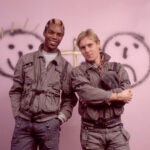In the early 2000s, amid the rising tides of “edgy” sitcoms and envelope-pushing sketch comedy, a strange, irreverent, and brilliant little show slipped onto the airwaves. It didn’t last long. It barely made a dent in the ratings. But for those who were paying attention, Greg the Bunny was something special—too strange to survive, too smart to forget. Dismissed by network executives and largely ignored by mainstream audiences, Greg the Bunny has since become a cult classic: a misunderstood experiment in meta-satire, media deconstruction, and sheer puppet-powered absurdity.
At its core, Greg the Bunny was a bold fusion of two worlds rarely explored together—puppets and adult humor. But it wasn’t crass for the sake of shock, nor was it just The Muppet Show with swear words. It was, rather, a satirical lens focused on television itself, with biting commentary on Hollywood, racism, artistic compromise, and the bizarre marriage of commerce and creativity. What doomed it in its time is exactly what has earned it a place in the pantheon of overlooked television brilliance.
A Premise Ahead of Its Time
The premise of Greg the Bunny is so outlandish it should never have worked—and yet, it’s precisely that absurdity that gave it its razor-sharp edge. In the world of the show, puppets—called “fabricated Americans”—live among humans as sentient beings. They’re not magical or metaphorical—they’re citizens, co-workers, and marginalized minorities. Greg, a sweetly naive rabbit puppet, lands a job as a cast member on Sweetknuckle Junction, a children’s TV show clearly modeled after Sesame Street but warped through a cynical, cable-network lens.
The brilliance lies in how Greg the Bunny used this puppet-human coexistence not just for laughs, but for layered satire. Puppets face discrimination, labor exploitation, and typecasting. They’re second-class citizens in the entertainment industry. While Greg dreams of being taken seriously as an actor, his puppet identity means he’s stuck playing goofy background characters. This metaphor—puppets as a stand-in for any marginalized creative voice—wasn’t just clever. It was scathing.
Years before shows like BoJack Horseman or Community made meta-comedy fashionable, Greg the Bunny was already there, digging its felt claws into the absurdity of showbiz with equal parts warmth and venom. It was, in many ways, a show about making a show—infinitely self-referential, often bleak, but always hilarious.
A Cast as Bizarre as It Was Brilliant
The show’s human cast was anchored by Seth Green, playing Jimmy, a production assistant who becomes Greg’s reluctant handler, best friend, and occasional moral compass. Seth Green was perfectly cast—his inherent likability made Jimmy’s growing disillusionment sympathetic rather than sour. He played off the puppets like they were real, grounding the insanity in something authentic.
But the standout human character, hands down, was Eugene Levy as Gil Bender, the jaded director of Sweetknuckle Junction. Levy played Gil as a once-promising filmmaker now reduced to directing children’s television populated by costumed weirdos and condescending executives. His despair was palpable, his delivery droll perfection. It was Levy at his finest—long before Schitt’s Creek gave him another platform to explore regret, ego, and reinvention.
On the puppet side, the stars were undeniable. Greg himself, voiced by show co-creator Dan Milano, was wide-eyed and endearing but not above casual selfishness. There was Warren “The Ape” DeMontague, a pompous, alcoholic thespian monkey with a superiority complex. Tardy Turtle, an impossibly slow-witted and sweet character, became a breakout figure thanks to his tragicomic innocence. Blah, the agitated, barely intelligible blue monster, rounded out a cast of puppets who were essentially character actors trapped in a system that didn’t value them.
The dynamic between humans and puppets was never treated as gimmick. It was part of the world’s logic. They shared union troubles, dating mishaps, career anxiety, and existential dread. And the more seriously the show took this ridiculous concept, the more profound its satire became.
Humor With a Brain—and a Backbone
What made Greg the Bunny such an anomaly was how fearlessly it challenged its own medium. It wasn’t just poking fun at television tropes—it was dissecting them. The show deconstructed genre, parodied network interference, and laid bare the artificiality of TV production. One episode would riff on reality TV’s manufactured drama, another would parody workplace sitcoms, while another might break the fourth wall entirely.
But buried beneath the gags was a real point of view. In portraying puppets as a mistreated underclass, Greg the Bunny managed a level of social satire that many dramas don’t even reach. The episode “Greg Gets Puppish” tackled cultural assimilation and identity politics in a way that was both ridiculous and deeply revealing. Greg is accused of “acting too human” and forgetting his roots, prompting a soul-searching journey that’s equal parts identity crisis and absurdist sketch comedy. That the show used a rabbit puppet to explore the emotional weight of cultural self-erasure is insane—but it worked.
The show’s take on the entertainment industry was similarly ruthless. Everyone in Sweetknuckle Junction is clawing for respect, meaning, or at least a little dignity. Whether it’s Warren the Ape’s Shakespearean delusions or Gil’s attempts to regain creative control, the show skewered the notion that talent and effort are ever enough in an industry built on compromise and cliché. The laughs were sharp, but they hurt because they were honest.
Censorship, Network Sabotage, and the Fox Factor
So why didn’t it last?
The simplest answer is Fox. The network that launched Greg the Bunny in 2002 had already developed a reputation for greenlighting unique shows (Futurama, Family Guy, Undeclared) only to fumble them with poor scheduling, constant meddling, and a quick trigger finger on cancellations. Greg the Bunny was given a confusing time slot, shuffled around without warning, and subjected to ruthless executive interference that dulled some of its creative edge.
Early episodes of the show leaned more into puppetry-as-prejudice metaphors and TV industry satire, but as Fox’s grip tightened, the show was pushed toward more traditional sitcom formulas. Some episodes were re-edited, entire arcs were dropped, and eventually the show was yanked mid-season.
And yet, even within that chaos, the brilliance still shone through. There’s a reason so many fans of the show still speak of it with near-religious reverence. You could see the show constantly trying to break out of the box it had been forced into—sometimes literally, as Greg and Warren would monologue directly to the camera about their off-screen frustrations. The puppets weren’t just characters. They were avatars for the creators themselves, trapped inside a system they couldn’t control.
The Resurrection—and the Afterlife
While the original Fox version only aired 13 episodes (with some never even seeing broadcast), Greg the Bunny wasn’t entirely buried. In the years that followed, a resurrection of sorts occurred on IFC, the Independent Film Channel, where the show returned to its sketch comedy roots in the form of short film parodies. These segments were looser, weirder, and truer to the creators’ original vision—each parodying a classic movie with the cast of puppets playing all the roles.
From Pulp Fiction to Godzilla to Easy Rider, the sketches were love letters to film culture, delivered through the same lens of absurdist critique. Warren the Ape’s bloviating commentary, Greg’s wide-eyed enthusiasm, and the general chaos of blending genre parody with puppet anarchy made these sketches cult favorites.
Still, it wasn’t quite the same. The IFC revival allowed the creators freedom, but lacked the long-form narrative depth and character development that the Fox version, for all its flaws, had begun to cultivate. Yet, even this afterlife kept the torch burning, and ensured that Greg the Bunny would never be fully forgotten.
Cultural Legacy and Quiet Influence
While it may not get name-checked as often as The Office or Arrested Development, the legacy of Greg the Bunny is visible in many of the boundary-pushing comedies that followed. BoJack Horseman, with its mixture of anthropomorphic absurdity and emotional depth, owes a creative debt to Greg and Warren. Community’s willingness to deconstruct TV genres with sincerity and satire mirrors the sensibilities first explored in Greg the Bunny.
Even the resurgence of adult puppet shows (Crank Yankers, The Happytime Murders, Don’t Hug Me I’m Scared) suggests a broader cultural acceptance of what Greg the Bunny tried to do—fuse childish visuals with adult commentary, and treat puppets not just as props, but as legitimate characters in their own right.
More importantly, Greg the Bunny proved that high-concept comedy didn’t have to sacrifice intelligence. It challenged viewers to laugh while they thought, to engage with ideas through characters that looked ridiculous but spoke hard truths. It was a show about compromise that refused to fully compromise itself. That alone is heroic.
A Final Word from the Puppet Underground
In hindsight, Greg the Bunny was never going to be a hit. It was too strange, too specific, and too smart for a prime-time network sitcom slot. It asked too much of its audience—not just to laugh, but to interrogate the medium they were watching. It invited viewers to consider how stories are made, who gets to tell them, and what’s lost when we treat creativity like a commodity.
In a better world, it might have run for years. It might have grown into something as revered as The Simpsons or 30 Rock. But in many ways, its brief existence only adds to its mythos. Greg the Bunny is that rare show that feels like a secret—a piece of pop culture gold buried just beneath the surface, waiting for the right person to stumble upon it and wonder how the hell it ever got made.
Misunderstood? Absolutely. A classic? No question.
So here’s to Greg, Warren, Tardy, and Blah—to the puppets who saw through the bullshit and dared to dream. The show may be gone, but its felt-covered soul lives on.
Watch The First Episode Here
This post has already been read 2 times!









